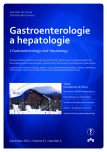Diagnosis of disorders of gastric emptying in diabetic patients with diabetic autonomic neuropathy
Authors:
M. Pipková; Š. Malá; J. Šťovíček; MUDr. Marek Honka; M. Kvapil
Authors‘ workplace:
Interní klinika 2. LF UK a FN v Motole, Praha
Published in:
Gastroent Hepatol 2013; 67(6): 488-493
Category:
Clinical and Experimental Gastroenterology: Original Article
Overview
Involvement of the gastrointestinal tract in patients with diabetes is common and is a serious problem due to the frequency of occurrence, the impact on the reduced quality of life and the effect on glycemic control. After 20 years of diabetes it occurs in 30 to 60% of patients. Gastroparesis is a disorder characterised by a significant delay in gastric emptying after a meal in the absence of a mechanical obstruction of gastric antrum or pylorus. Gastroparesis accounts for a very heterogeneous group of severe motor gastric disorders of various aetiology and diabetes mellitus accounts for about one third of all cases. The symptoms of gastroparesis occur in 5% to 12% patients of diabetes. Motility disorders of the gastrointestinal tract are subject to diabetic autonomy neuropathy in the intestinal tract. The gold standard test to diagnose gastroparesis is scintigraphy. Retention of more than 60% of the test meal in the stomach after two hours and 10% after four hours is considered evidence of a significant delay in gastric emptying. Another alternative method for assessing gastric function includes the gastric emptying breath test using 13C-octanoic acid or 13C-Na-acetate. These two methods do not investigate the same action. Ideally, therefore the two tests complement each other. The electrogastrography (EGG) is a method for testing the myoelectrical activity of the stomach. EGG has not yet been introduced into routine practice and its practical application in clinical practice still remains a question for the future.
Key words:
diabetes mellitus – diabetic autonomic neuropathy – gastroparesis – electrogastrography
The authors declare they have no potential conflicts of interest concerning drugs, products, or services used in the study.
The Editorial Board declares that the manuscript met the ICMJE „uniform requirements“ for biomedical papers.
Submitted:
14. 8. 2013
Accepted:
16. 9. 2013
Sources
1. Žáčková V. Zažívací potíže u diabetiků. Interní Med 2001; 7 : 299–304.
2. Bureš J, Šmahelová A, Tachecí I et al. Poruchy motility a evakuace žaludku u diabetika. Současné možnosti diagnostiky a léčby. Vnitř Lék 2011; 57(4): 351–355.
3. Vinik AI, Maser RE, Mitchell BD et al. Diabetic autonomic neutopathy. Diabetes Care 2003; 26(5): 1553–1579.
4. Perušičová J, Škrha J, Piťhová P. Současný pohled na hodnocení kompenzace diabetes mellitus. Diabetologie, metabolismus, endokrinologie, výživa 2008; 11(1): 19–30.
5. Stevens MJ. Diabetic autonomic neuropathy. UpToDate [online]. Available from: http://www.uptodate.com/contents/diabetic-autonomic-neuropathy.
6. Kojecký V. Dysmotilita horní části zažívacího traktu u diabetu. Med Pro Praxi 2007; 6 : 259–261.
7. UpToDate.Camilleri MD. Pathogenesis of delayed gastric emptying. [online]. Available from: http://www.uptodate.com/contents/pathogenesis-of-delayed-gastric-emptying.
8. Chang J, Rayner CK, Jones KJ et al. Diabetic gastroparesis-backwards and forewards. J Gastroenterol Hepatol 2011; 26 (Suppl 1): 46–57.
9. Parkman HP, Camilleri M, Farrugia G et al. Gastroparesis and functional dyspepsia: excerpts from the AGA/ANMS meeting. Neurogastroenterol Motil 2010; 22(2): 113–133.
10. Patrick A, Epstein O. Review article: gastroparesis. Aliment Pharmacol Ther 2008; 27(9): 724–740.
11. Parkman HP, Hasler WL, Barnet JL et al. Electrogastrography: a dokument prepared by the gastric section of the American Motility Society Clinical GI Motility Testing Task Force. Neurogastroenterol Motil 2003; 15(2): 89–102.
12. Zdárská D, Pelísková P, Charvát J et al. ECG body surface mapping (BSM) in type 1 diabetic patients. Physiol Res 2007; 56(4): 403–410.
13. Chang FY. Electrogastrography: basic knowledge, recording, processing and its clinical applications. J Gastroenterol Hepatol 2005; 20(4): 502–516.
Labels
Paediatric gastroenterology Gastroenterology and hepatology SurgeryArticle was published in
Gastroenterology and Hepatology

2013 Issue 6
- Metamizole at a Glance and in Practice – Effective Non-Opioid Analgesic for All Ages
- Metamizole in perioperative treatment in children under 14 years – results of a questionnaire survey from practice
- Possibilities of Using Metamizole in the Treatment of Acute Primary Headaches
- The Importance of Limosilactobacillus reuteri in Administration to Diabetics with Gingivitis
Most read in this issue
- Diagnosis of disorders of gastric emptying in diabetic patients with diabetic autonomic neuropathy
- Endoscopic resolution of refractory postoperative bile leak from bile duct with fully covered self-expandable metallic stent
- Guidelines of the Czech gastroenterological society – endoscopic treatment of Barrett´s esophagus and early esophageal neoplasia
- Hepatocellular carcinoma – our experience with surveillance, effect and complications of transarterial chemoembolization
